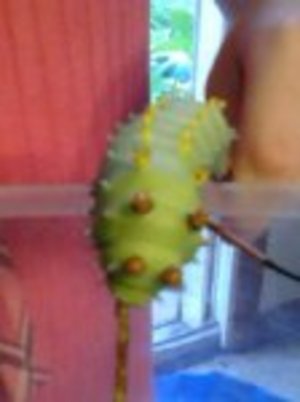It all began innocently enough. I spied a cute little caterpillar crawling up my kitchen wall last September. I escorted my little buddy out the back door, scolded him for coming inside and thought no more about it. But then I saw another caterpillar in the kitchen. A third mysteriously plopped unto the stove as I was adding spices to my spaghetti sauce. This was enough for me to head to the computer and do a search for “little caterpillars in my kitchen.” The search revealed the verdict: Indian meal moth larvae. Well, yes, I do remember some moths that entered the house over the summer. And yes, they did kind of hang around for a while because I didn’t want to bother to drag out the step stool and kill them (after all, what harm can a moth do?). Oh, and I did even see one or two in the cabinets, but I thought maybe they just accidentally flew in. But this was not just an accident; this was an infestation.
I am a veteran of roaches and mice, so the moth problem seemed to be a rather trifling issue. Still, I was determined to conquer this intruder. I continued to investigate further and found several discussion loops on the Internet devoted to this singular topic. I learned more than I wanted to know about this little pest. The moth lays her eggs in stored food, in the cracks and crevices of your cabinets where crumbs may be lodged, or even in food that has fallen behind your stove. The larvae that hatch are, at first, too small to be seen, and feed on the food product they are in until it is time to pupate. They then leave their food source to find a place to make their cocoon. Before too long, a new generation of moths has emerged.
I quickly found the source of my problems- an old bag of walnuts in my spice cabinet. Closer inspection of the cabinet revealed numerous caterpillars, and a large number of cocoons. I had to look carefully in the nooks and crannies. The award for most innovative place to pupate goes to the half dozen or so larvae that choose to climb up my spice jars into the grooves where the lids screw on (thus the explanation for my plopping caterpillar friend). Who can know the mind of a meal moth caterpillar?
If you find yourself with a meal moth problem, here are some steps you can take:
- kill the moths you see in your house
- locate the source of your problem-usually an old package of corn meal, pasta, nuts, cereal, etc.
- throw the infested package away OUTSIDE
- carefully inspect and clean your cabinets, behind your appliances, etc.
- assume you might have eggs or larvae in other packages in the vicinity of your originally infested package. You might choose to 1) throw these items away, 2) put these items in the freezer for 48 hours to kill any eggs/larvae, or 3) enclose the items in re-sealable plastic bags and watch them several weeks for any caterpillar/moth activity
- There are sticky traps available that use pheromones, odors undetectable to humans, but attractive to the moths, to lure the moths inside. These traps are not meant for control, but as a detection device. If your traps are empty, your moths are probably gone.
How did my story end? For several weeks, I continued to see a moth or two and to find a missed cocoon here and there. Eventually, I saw no more moths…until I saw one flutter by right a few months ago. Then I saw another one, then two more…This is not just round two; this is all out war.
For more information: http://www.ext.colostate.edu/Pubs/insect/05598.html




